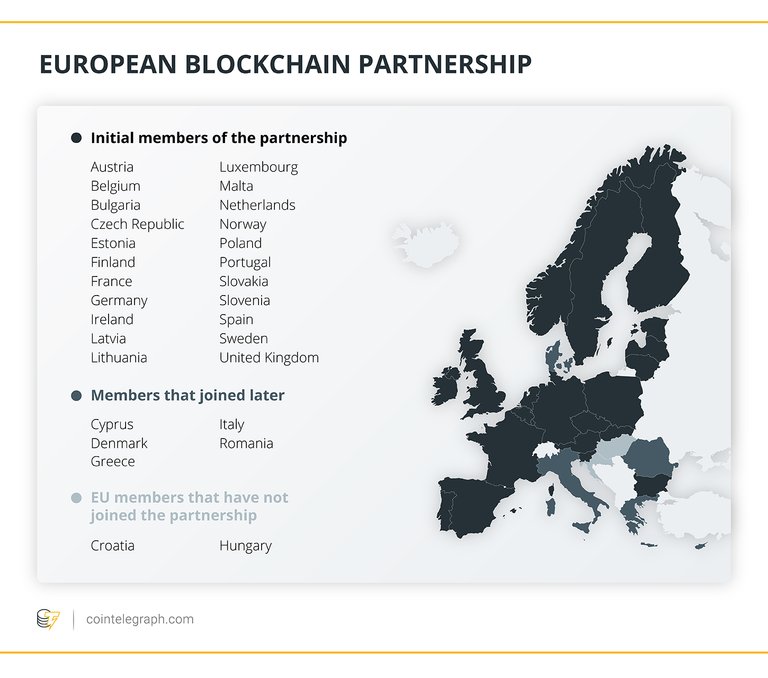
On April 10, 2018, 21 EU member states and Norway signed up to create the European Blockchain Partnership. Including the UK, France, Germany, Sweden, the Netherlands and Ireland, they committed themselves to "cooperate in the establishment of a European Blockchain Services Infrastructure (EBSI) that will support the delivery of cross-border digital public services, with the highest standards of security and privacy."
Since April, a further five nations have joined the Partnership, with Italy becoming the latest to do so after it signed the Partnership's Declaration in September. As a member, it has committed itself to helping to identify, by the end of 2018, "an initial set of cross-border digital public sector services that could be deployed through the European Blockchain Services Infrastructure."
By bringing distributed ledger technology (DLT) to European infrastructure, the Partnership hopes to make cross-border services – such as those related to logistics and regulatory reporting – safer and more efficient. However, progress towards this goal has so far been slow and piecemeal, with the Partnership's members having had only three meetings since April. Nonetheless, it retains ambitious aims, with the European Commission telling Cointelegraph that it wants the European Blockchain Services Infrastructure (EBSI) to become an international "gold standard" for large-scale DLTs.

Still deciding
So far, the Partnership's mission is vaguely defined. While there was already agreement in April that it would work towards developing cross-border, blockchain-based public services, there is still no actual agreement on what particular services to hone in on and develop. The European Commission's head of Digital Innovation and Blockchain, Pēteris Zilgalvis explains:
"The Partnership's mission is defined in the Joint Declaration and it is on that mandate that we have to deliver before the end of the year. In the Joint Declaration the signatories committed to working together and with the European Commission in order to develop an EBSI that can support the delivery of cross-border digital public services in Europe. So the description of what this services' infrastructure [EBSI] could look like is what we are currently working on."
In other words, the Partnership's membership is currently at the very early stage of negotiating just what kind of blockchain-based public services to develop. However, as Zilgalvis explained to Cointelegraph, it expects to have agreed on all the fundamental details by the end of the year, so that these can be used as the basis for actually building and rolling out distributed cross-border technologies.
"As stated in the Joint Declaration, by end of 2018 the Partnership must provide a set of use cases of cross-border digital public services that could be deployed through the EBSI, a set of functional and technical specifications for the EBSI and finally, a governance model describing how the EBSI will be managed."
A global reference for blockchain
The Partnership and its members will therefore be busy for the rest of 2018, although it has only three more meetings left to hammer out the all-important details, having already had three meetings so far. According to Finland's representative to the Partnership, Kimmo Mäkinen, a senior advisor at the Department of Public Sector Digitalization, the most recent meeting took place on September 17. "This was the third meeting," he tells Cointelegraph. "The main topic was to discuss about the most prominent cross-border blockchain use-cases that had been proposed by member states and by the commission."
As for whether the Partnership will successfully decide on all the necessary parameters before the start of 2019, Mäkinen doesn't offer confirmation. "We will have three monthly meetings by the end of this year during which we will have to agree not only on use-cases but also technical/functional requirements and governance model for European blockchain infrastructure," he says, his use of "not only" implying that the Partnership has a more-than sizeable workload to get through before Christmas.
Still, even though three meetings and no particular end-product hardly counts as an impressive achievement, these meetings were positive for the Partnership. More importantly, they've revealed a strong commitment among its members towards developing blockchain technologies, as explained by Pēteris Zilgalvis:
"At these meetings we found that the Partners were extremely supportive of collective efforts to establish strong EU leadership in distributed ledger technology, drawing on the Digital Single Market framework, and that EBSI could play a very important role in achieving this objective."
Indeed, it would appear that the European Blockchain Partnership is being used by the European Commission as a vehicle for the EU becoming a global leader on DLT.
"In the longer term, we would like EBSI to become a global reference when it comes to trusted blockchain infrastructures," admits Zilgalvis, "a 'gold standard' infrastructure that is governed through a transparent multi-stakeholder organisation, meets the most advanced cybersecurity and energy efficiency standards, is scalable to accommodate different use cases, is highly-performant in terms of speed and throughput, ensures the continuity of services on the long term, integrates eIDAS (electronic IDentification, Authentication and trust Services) and supports full compliance with the EU requirements on data protection (General Data Protection Regulation) and network information security."
So even if the Partnership hasn't really achieved anything concrete yet, its significance lies in the fact that it represents a massive vote of confidence in blockchain technology. By committing to it, and by aiming to build "highly-performant" blockchain tech, the Partnership's 27 member nations have effectively declared that they believe DLT is here to stay and that it has genuine applicability to a range of areas.
Separately, each member is for their own purposes interested in blockchain tech from a variety of different perspectives, further testifying to blockchain's growing status as a promising new solution to a range of problems. "Finland is interested and curious of new possibilities that are to be presented by blockchain technology," acknowledges Kimmo Mäkinen, "in order to boost cross-border services for example in matters related to document authenticity, data exchange and identity management."
Implementation mode in 2019?
Of course, while there's little doubt that the Partnership's signatories are completely serious about DLT, there still remains the unavoidable question of when, exactly, it will produce and begin introducing the platforms it was set up to build. Well, despite there not being anything absolutely definite on this front, Pēteris Zilgalvis states that we may begin seeing actual output as early as next year:
"These deliverables [functional and technical specifications, governance model] will be addressed to the political representatives who signed the Declaration, and if approved, the Partnership could move into implementation mode in 2019."
Once again, this time frame is ambitious. But even if certain differences of opinion may need to be ironed out between members before implementation can begin, the target of 2019 shows just how confident the European Commission is that the Partnership's member states are on the same page with regards to blockchain, which is further indicated by them signing its Declaration in the first place. If the Partnership does indeed follow through with its plans and implements blockchain-based cross-border infrastructure, this will only have positive ramifications and knock-on effects for wider blockchain adoption elsewhere. All of which means that the future of blockchain adoption in Europe looks increasingly bright.
Hi! I am a robot. I just upvoted you! I found similar content that readers might be interested in:
https://cointelegraph.com/news/the-european-blockchain-partnership-finds-europe-getting-serious-about-distributed-ledger-technology